Understanding the Bevel Gauge in Woodworking
In the world of woodworking, precision is key. One essential tool that helps woodworkers achieve accurate angles is the bevel gauge. But what exactly is a bevel gauge? A bevel gauge, also known as an angle finder, is a tool used to measure and transfer angles. It consists of a blade, stock, and locking mechanism. The blade is the part that indicates the angle, the stock is the handle that holds the blade, and the locking mechanism secures the blade in place once the desired angle is set.
Accurate angles are crucial in woodworking for various reasons. Whether you are creating angled joints, cutting bevels on edges, or making precise cuts for furniture, having the correct angle is essential for a successful project. A bevel gauge ensures that angles are measured and replicated accurately, leading to seamless woodworking projects with professional results.
The purpose of this article is to provide a comprehensive guide to understanding, choosing, and using a bevel gauge in woodworking. From the different types of bevel gauges available to tips for effective usage and common mistakes to avoid, this article aims to equip woodworkers with the knowledge and skills needed to make the most out of this versatile tool.
Our Top Bevel Gauge Picks
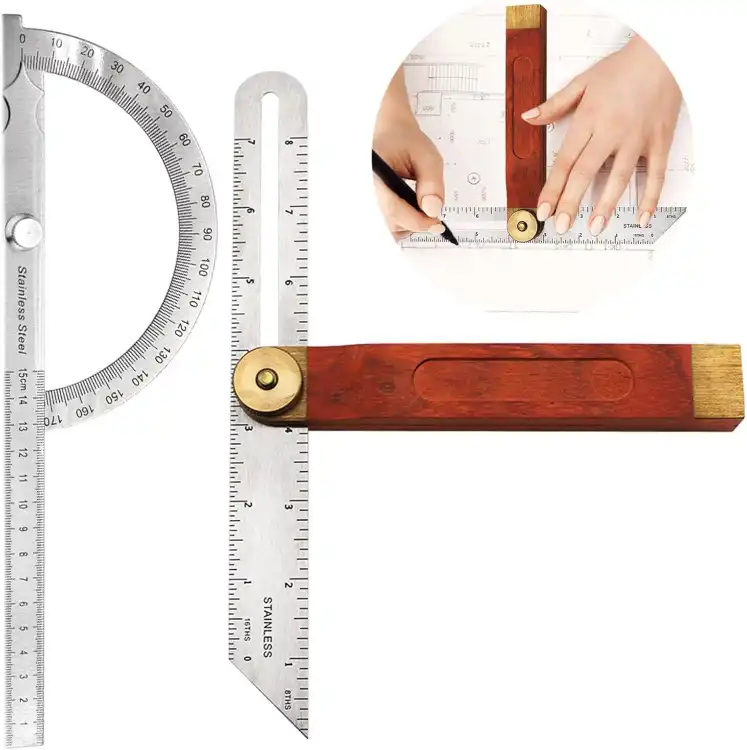
2Pcs Angle Protractor, T Bevel Angle Finder with Wooden Handle Sliding T-Bevel Bevel Gauge for Carpenter
Check on AmazonKey Specs:
- Material: Stainless steel, wooden handle, and brass components
- Angle Range: 0-360° for the carpentry square, 0-180° for the protractor
- Measurement Units: Double-sided scale (cm/inch) for carpentry square, cm scale for protractor
- Adjustability: Adjustable screw for precise readings
- Package: Includes 1 carpentry square (0-7.87 inches) and 1 protractor (0-5.91 inches)
This 2-piece Angle Protractor and T-Bevel Set by QWLWBU is a versatile and durable tool for any carpenter or craftsman. The stainless steel construction paired with a wooden handle ensures both strength and comfort for prolonged use. The 360-degree rotation of the carpentry square makes it incredibly flexible for replicating angles, while the protractor allows for precise angle measurements between 0° and 180°. The double-sided scale provides easy-to-read graduations in both inches and centimeters, making it a must-have for any professional.
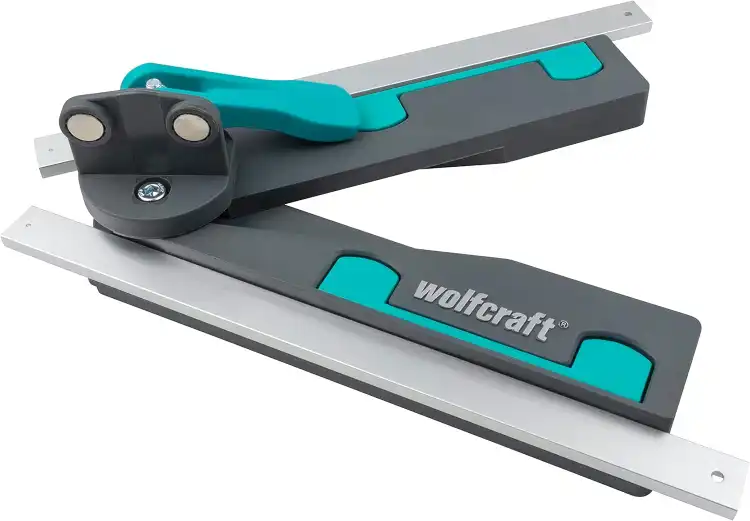
wolfcraft Angular Bevel Gauge for Mitre Saws I 6957000 I For measuring and transferring angles
Check on AmazonKey Specs:
- Angle Range: Measures angles from 30° to 180°
- Material: High-speed steel blade
- Additional Features: Automatic angle bisector for accurate mitre cuts
- Included Accessories: Telescopic corner callipers and foldable stop for marking
- Surface Compatibility: Designed for use on plastic surfaces
The wolfcraft Angular Bevel Gauge is an excellent tool for anyone working with mitre saws. Its ability to measure and transfer angles from 30° to 180° is essential for accurate cuts, making it indispensable for both professionals and DIYers. The automatic angle bisector ensures perfect mitre cuts every time, reducing the chance for errors. I particularly appreciate the telescopic corner callipers for outside corners and the foldable stop, which makes marking and alignment quick and precise.
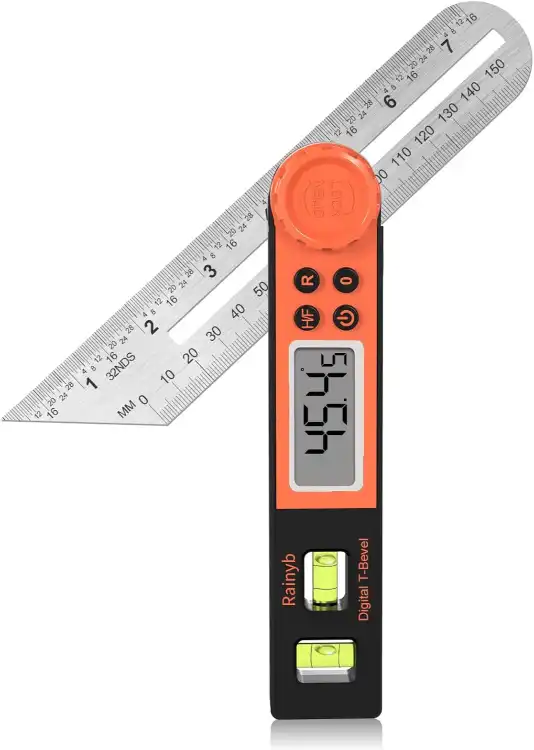
Digital Angle Finder Protractor 0-360 Degree T-Bevel Gauge
Check on AmazonKey Specs:
- Angle Range: 0-360°
- Accuracy: ±0.5°
- Resolution: 0.05°
- Display: Large LCD with flip and reverse function
- Additional Features: Built-in bubble level for accuracy
The Digital Angle Finder Protractor is a game-changer for precise angle measurement. I love its full 360° range, which allows me to measure internal, external, and contra angles with high accuracy. The ±0.5° precision and 0.05° resolution make it perfect for woodworking, metalworking, and construction. The large LCD display makes it incredibly easy to read, even in low light. The built-in bubble level ensures I’m always working on a level surface, and the four large control buttons make it user-friendly.
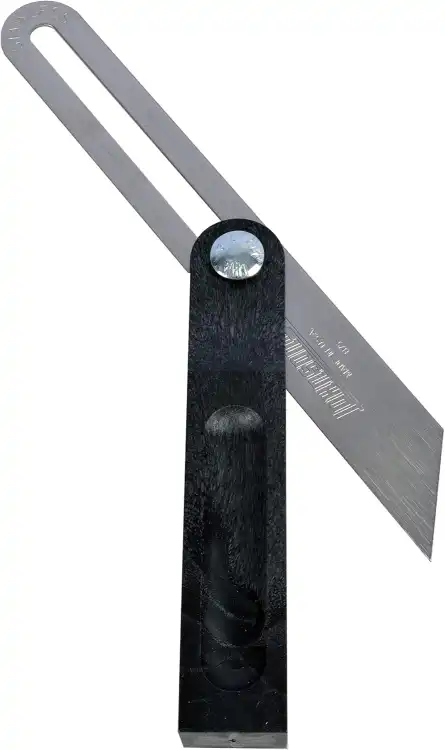
Johnson Level & Tool B75 T-Bevel – Structo-Cast Handle, 9″, Silver, 1 T-Bevel
Check on AmazonKey Specs:
- Blade: Adjustable stainless steel, rust-resistant
- Handle: High-impact Structo-Cast with ergonomic grip
- Angle Range: 0° to 360°
- Locking Nut: Secure blade in place for precision
- Application: Ideal for cabinets, furniture, and tiling projects
The Johnson Level & Tool B75 T-Bevel is an essential tool for any carpenter or DIYer. I appreciate its durable stainless steel blade, which resists rust and corrosion, ensuring longevity. The high-impact Structo-Cast handle is ergonomically designed, making it comfortable to use while providing a secure grip. The locking nut holds the blade firmly in place, making angle duplication simple and precise. Whether measuring or transferring angles for cabinetry or furniture, this tool delivers accurate results every time.
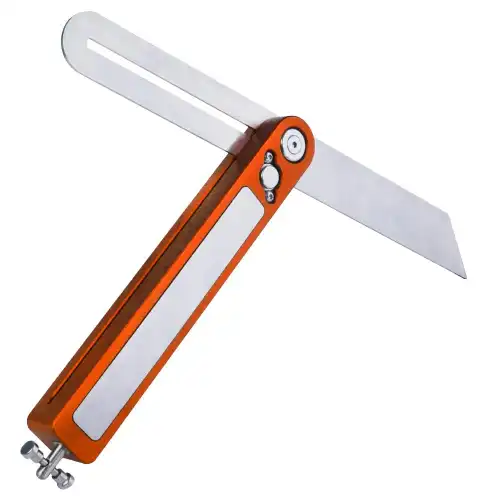
O’SKOOL Sliding T Bevel Gauge with 10″ Stainless Steel Blade and Aluminum Handle
Check on AmazonKey Specs:
- Blade: 10-inch stainless steel, rust-resistant
- Handle: Durable, aesthetically appealing aluminum
- Locking Mechanism: Locks the blade securely at any angle
- Angle Range: 0° to 360° adjustable
- Applications: Ideal for woodworking projects like furniture, cabinets, and framing
The O’SKOOL Sliding T Bevel Gauge with a 10″ stainless steel blade is a top-notch tool for precise angle measurement and transfer. I’m particularly impressed by the aluminum handle, which strikes a perfect balance between durability and aesthetics. The 360-degree adjustable blade offers ultimate versatility, while the secure locking mechanism ensures angles stay fixed during use. Whether I’m crafting cabinets or picture frames, this tool’s accuracy and ease of use make it indispensable for any woodworker or DIY enthusiast.
Understanding the Parts of a Bevel Gauge
When it comes to using a bevel gauge effectively, understanding its parts is crucial. Here are the main components of a bevel gauge:
Parts of a Bevel Gauge:
| Part | Description |
|——————–|————————————————–|
| Blade | Indicates the angle measurement |
| Stock | Handle that holds the blade |
| Locking Mechanism | Secures the blade in place at the desired angle |
Knowing how each part functions and interacts with the others will help you manipulate the bevel gauge accurately for precise angle measurements in your woodworking projects.
Types of Bevel Gauges
Bevel gauges come in different types to cater to varying needs and preferences. The two main types of bevel gauges are manual bevel gauges and digital bevel gauges.
Manual Bevel Gauge:
– Traditional tool operated by manually adjusting the angle.
– Often preferred by woodworkers for its simplicity and reliability.
– Requires physical manipulation to set and lock the desired angle.
Digital Bevel Gauge:
– Modern tool equipped with digital displays for precise angle readings.
– Ideal for woodworkers who prefer digital accuracy and convenience.
– Allows for quick and easy angle adjustments at the touch of a button.
Choosing the right type of bevel gauge depends on your personal preference, the complexity of your woodworking projects, and the level of precision required for your angles. Each type has its advantages and can be a valuable addition to your woodworking toolkit.
Choosing the Right Bevel Gauge for Your Project
Selecting the appropriate bevel gauge for your woodworking project is essential to ensure accurate angle measurements. Consider the following factors when choosing a bevel gauge:
Consider the Angle Range Needed:
– Determine the range of angles you will be working with to select a gauge that accommodates your requirements.
– Some gauges offer a wider range of angle measurements, providing versatility for various projects.
Quality of Materials:
– Opt for a bevel gauge made from durable materials like stainless steel or aluminum for longevity and accuracy.
– High-quality materials ensure that the gauge maintains its precision over time, even with frequent use.
Ease of Use:
– Choose a bevel gauge that is user-friendly and easy to manipulate for seamless angle adjustments.
– Look for features like clear markings, ergonomic design, and smooth locking mechanisms for convenience.
By considering these factors, you can confidently choose a bevel gauge that meets your woodworking needs and helps you achieve precise angles in your projects.
Setting Up the Bevel Gauge
Once you have selected the right bevel gauge for your project, it’s essential to know how to set it up correctly for accurate angle measurements. Follow these steps to set up your bevel gauge effectively:
Unlocking the Blade:
– Release the locking mechanism to allow the blade to move freely.
– Ensure that the blade can be adjusted without any obstructions for precise angle setting.
Adjusting the Angle:
– Rotate the blade to the desired angle by aligning it with the angle markings on the stock.
– Take your time to adjust the angle slowly and carefully to achieve the exact measurement needed for your project.
Locking the Blade in Place:
– Once the desired angle is set, secure the blade in place by tightening the locking mechanism.
– Double-check the angle to ensure that it remains stable and accurate before proceeding with your woodworking tasks.
By following these steps, you can set up your bevel gauge accurately and confidently measure angles for your woodworking projects with precision.
Techniques for Accurate Angle Measurement
Achieving precise angle measurements with a bevel gauge requires proper techniques and attention to detail. Here are some techniques to help you measure angles accurately:
Using a Reference Angle:
– Use a known angle or a reference tool like a protractor to verify the accuracy of your bevel gauge.
– Comparing your measurements with a reference angle can help you calibrate your gauge and ensure precise results.
Checking for Squareness:
– Confirm that the blade of the bevel gauge is square with the edge of your workpiece before taking measurements.
– Ensuring squareness eliminates errors and guarantees that your angles are measured correctly for seamless woodworking joints.
Double-Checking Measurements:
– Verify your angle measurements multiple times to eliminate any potential errors or discrepancies.
– Double-checking ensures that your angles are consistent and accurate, leading to professional-quality woodworking results.
By incorporating these techniques into your angle measurement process, you can enhance the accuracy and reliability of your bevel gauge measurements for successful woodworking projects.
Common Mistakes to Avoid
While using a bevel gauge, it’s essential to be aware of common mistakes that can compromise the accuracy of your angle measurements. Avoid the following pitfalls to ensure precise results in your woodworking tasks:
Misreading the Scale:
– Misinterpreting the markings on the bevel gauge can lead to incorrect angle measurements.
– Take your time to read the scale accurately and align the blade with the correct angle for precise results.
Not Securely Locking the Blade:
– Failing to lock the blade securely in place can result in angle shifts and inaccurate measurements.
– Always double-check that the blade is firmly locked before proceeding with your woodworking cuts to maintain precision.
Ignoring Calibration:
– Neglecting to calibrate your bevel gauge regularly can lead to inaccuracies over time.
– Calibrate your gauge periodically, especially if you notice discrepancies in your angle measurements, to ensure consistent and reliable results.
By avoiding these common mistakes and practicing proper usage techniques, you can maximize the effectiveness of your bevel gauge and achieve accurate angle measurements in your woodworking projects.
Tips for Using a Bevel Gauge Effectively
To make the most out of your bevel gauge and enhance its usability in woodworking, consider the following tips for effective usage:
Practice on Scrap Wood First:
– Before making cuts on your actual workpiece, practice setting and measuring angles on scrap wood.
– Practicing helps you familiarize yourself with the gauge and ensures that you can achieve accurate angles when working on your project.
Marking the Angle on the Wood:
– Once you have set the desired angle with your bevel gauge, mark it on the wood using a pencil or marking tool.
– Marking the angle helps you visualize the cut lines and ensures that you maintain the correct angle throughout your woodworking task.
Regular Maintenance of the Gauge:
– Keep your bevel gauge clean and free from debris to prevent any obstructions that may affect its accuracy.
– Periodically check and calibrate your gauge to maintain its precision and reliability for consistent angle measurements.
By incorporating these tips into your woodworking routine, you can optimize the use of your bevel gauge and achieve professional results in your projects.
Applications of Bevel Gauges in Woodworking
Bevel gauges play a crucial role in various woodworking applications, allowing woodworkers to achieve precise angles for a wide range of tasks. Here are some common applications of bevel gauges in woodworking:
Creating Angled Joints:
– Bevel gauges are essential for creating angled joints like miter joints, bevel joints, and dovetail joints.
– Accurate angle measurements ensure that the joints fit together seamlessly for sturdy and visually appealing woodworking connections.
Cutting Bevels on Edges:
– When cutting bevels on edges of wood pieces, bevel gauges help woodworkers achieve consistent and uniform angles.
– Bevel gauges ensure that the beveled edges align perfectly, enhancing the overall aesthetics of the woodworking project.
Making Precise Cuts for Furniture:
– Whether cutting angled legs for a table or creating intricate designs on furniture pieces, bevel gauges are indispensable for precise cuts.
– By accurately measuring and transferring angles, woodworkers can craft furniture with intricate details and structural integrity.
By leveraging the versatility and accuracy of bevel gauges in these woodworking applications, craftsmen can elevate the quality and craftsmanship of their projects with confidence.
Advantages of Using a Bevel Gauge
Utilizing a bevel gauge in woodworking offers numerous advantages that contribute to the efficiency and precision of your projects. Here are some key benefits of using a bevel gauge:
Accuracy in Angle Measurements:
– Bevel gauges provide precise angle measurements, allowing woodworkers to replicate angles consistently.
– Accurate angles ensure that woodworking joints fit together seamlessly and that cuts are made with precision for professional results.
Versatility in Woodworking Projects:
– With the ability to measure and transfer various angles, bevel gauges are versatile tools for a wide range of woodworking tasks.
– From creating complex joints to cutting decorative angles, bevel gauges enhance the versatility of woodworking projects.
Time-Saving Tool:
– By quickly and accurately measuring angles, bevel gauges help woodworkers streamline their workflow and save time on project setups.
– The efficiency of bevel gauges allows craftsmen to focus on the creative aspects of woodworking without compromising on accuracy.
By harnessing the advantages of bevel gauges in woodworking, craftsmen can elevate their craftsmanship, enhance project efficiency, and achieve professional-quality results with ease.
Comparison with Other Angle-Measuring Tools
While bevel gauges are essential tools for measuring and transferring angles in woodworking, they are not the only options available. Here’s a comparison of bevel gauges with other angle-measuring tools commonly used in woodworking:
Conclusion
In conclusion, the bevel gauge is a versatile and essential tool in woodworking that facilitates precise angle measurements for a wide range of projects. By understanding the parts of a bevel gauge, choosing the right type for your needs, and mastering techniques for accurate angle measurement, woodworkers can elevate the quality and precision of their woodworking tasks. Avoiding common mistakes, utilizing tips for effective usage, and exploring the applications of bevel gauges in woodworking enable craftsmen to achieve professional results with confidence and efficiency.
In summary, the bevel gauge offers unparalleled accuracy, versatility, and time-saving benefits in woodworking, making it a valuable tool for craftsmen of all skill levels. By comparing it with other angle-measuring tools, exploring real-life examples of its usage, and prioritizing safety precautions, woodworkers can harness the full potential of the bevel gauge in their woodworking endeavors. Whether creating angled joints, cutting bevels, or making precise cuts for furniture, the bevel gauge remains an indispensable tool for achieving exceptional craftsmanship and professional results in woodworking projects.
We encourage readers to practice using a bevel gauge in their woodworking projects, experiment with different angles, and explore the tool’s capabilities to enhance their skills and craftsmanship. With dedication, practice, and a keen eye for precision, woodworkers can master the art of angle measurement and elevate the quality of their woodworking creations with the help of this invaluable tool.
FAQ
What is a bevel gauge used for in woodworking?
A bevel gauge is used in woodworking to measure and transfer angles accurately for tasks such as creating angled joints, cutting bevels on edges, and making precise cuts for furniture.
How do I choose the right bevel gauge for my woodworking project?
When selecting a bevel gauge, consider factors such as the angle range needed, the quality of materials, and the ease of use to ensure that the gauge meets your woodworking requirements effectively.
What are some common mistakes to avoid when using a bevel gauge?
Common mistakes to avoid when using a bevel gauge include misreading the scale, not securely locking the blade in place, and ignoring calibration, which can lead to inaccurate angle measurements and compromised woodworking results.
How can I troubleshoot common issues with my bevel gauge?
If you encounter issues with your bevel gauge, such as the blade getting stuck, inaccurate angle readings, or rust on the blade, follow troubleshooting steps like cleaning the blade, recalibrating the gauge, or removing rust to restore its performance and accuracy.
What are the advantages of using a bevel gauge in woodworking projects?
Using a bevel gauge in woodworking offers advantages such as accuracy in angle measurements, versatility in project applications, and time-saving benefits, allowing woodworkers to achieve professional results with precision and efficiency.
